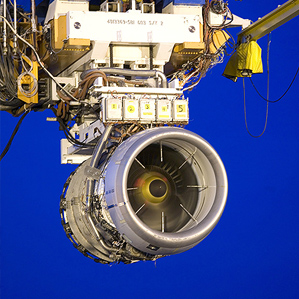A More Efficient Jet Engine Is Made from Lighter Parts, Some 3-D Printed
A new generation of engines being developed by the world’s largest jet engine maker, CFM (a partnership between GE and Snecma of France), will allow aircraft to use about 15 percent less fuel—enough to save about $1 million per year per airplane and significantly reduce carbon emissions.

The first of these new engine, called LEAP, will feature a technology that has never been used in a large-scale production jet engines before: ceramic composite materials that weigh far less than the metal alloys they’ll replace and can endure far higher temperatures. The engine will also make use of parts produced through 3-D printing, a new kind of manufacturing that can produce complex shapes that would be difficult or impossible to make with conventional manufacturing techniques (see “10 Breakthrough Technologies 2013: Additive Manufacturing”). These technologies could eventually be used to make more parts of the engine, leading to further advances in efficiency, says Gareth Richards, LEAP program manager for GE Aviation.
Even though construction of the first engine began less than two weeks ago, the company already has orders for 4,500. They will be used in the Airbus A320neo, the Boeing 737 Max, and a new plane from China, the Comac C919. In addition to saving money, the engine will help manufacturers comply with current and anticipated regulations designed to reduce emissions of carbon dioxide and pollutants such as smog-forming nitrogen oxides (NOx).
One of the key innovations is the use of ceramic matrix composites developed by GE. Ceramics can withstand high temperatures, but they’re normally too brittle for use in engines. Researchers at GE developed a way to reinforce them with silicon carbide fibers, which makes them as resilient as metal.
The ceramics will decrease the amount of energy used to cool off engine parts. Current engines operate at temperatures that are actually higher than the melting point of the nickel metal alloys used inside them; to keep them from melting, the engine diverts air from a compressor inside the engine through tiny holes in the parts, creating a protective cooling layer. The ceramic composite doesn’t require this cooling, so the air can instead be used to generate thrust.
In the LEAP engine, the ceramic matrix composites will replace only some of the nickel alloy parts. But in the future, they could be used for more engine parts, further reducing losses from cooling. This change could also allow engines to run at higher temperatures, making it possible to get more thrust from a given amount of fuel. Furthermore, composites could make engines lighter—parts made from these materials weigh one-third as much as the equivalent nickel alloy parts.
The engine will also feature 3-D-printed parts that can improve the engine’s efficiency and lower emissions. The system is more sophisticated and powerful than the desktop 3-D printers that have gained attention recently. Instead of depositing materials, it uses a laser to turn metal powder into solid shapes, layer by layer. The method simplifies the manufacturing of precisely shaped fuel nozzles that help the engine run at high temperatures without producing nitrogen oxides (see “Additive Manufacturing” and “GE and EADS to Print Parts for Airplanes”).
Another engine maker, Pratt & Whitney, is developing its own advanced engine that can reduce fuel consumption by about 15 percent; buyers of the Airbus A320neo can choose either the Pratt & Whitney engine or the CFM one. But Pratt & Whitney takes a far different approach to improving efficiency. Rather than using composites, it’s introducing gears that help different parts of the engine move at optimal speeds (see “More Efficient Jet Engine Gets in Gear” and “Hybrid Wing Uses Half the Fuel of a Standard Airplane”).
Keep Reading
Most Popular
Large language models can do jaw-dropping things. But nobody knows exactly why.
And that's a problem. Figuring it out is one of the biggest scientific puzzles of our time and a crucial step towards controlling more powerful future models.
The problem with plug-in hybrids? Their drivers.
Plug-in hybrids are often sold as a transition to EVs, but new data from Europe shows we’re still underestimating the emissions they produce.
How scientists traced a mysterious covid case back to six toilets
When wastewater surveillance turns into a hunt for a single infected individual, the ethics get tricky.
Google DeepMind’s new generative model makes Super Mario–like games from scratch
Genie learns how to control games by watching hours and hours of video. It could help train next-gen robots too.
Stay connected
Get the latest updates from
MIT Technology Review
Discover special offers, top stories, upcoming events, and more.